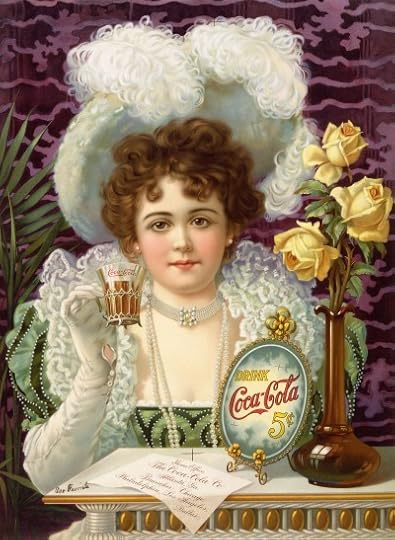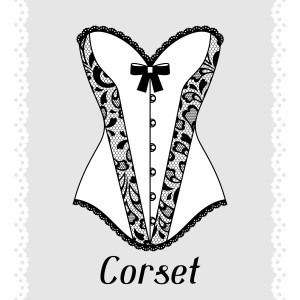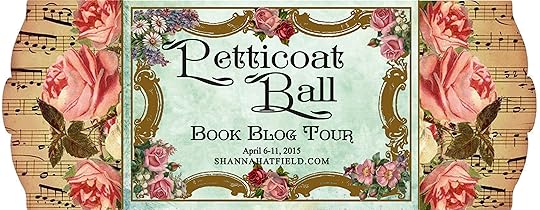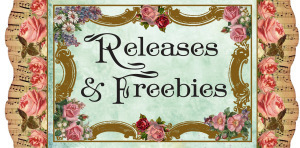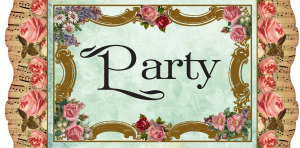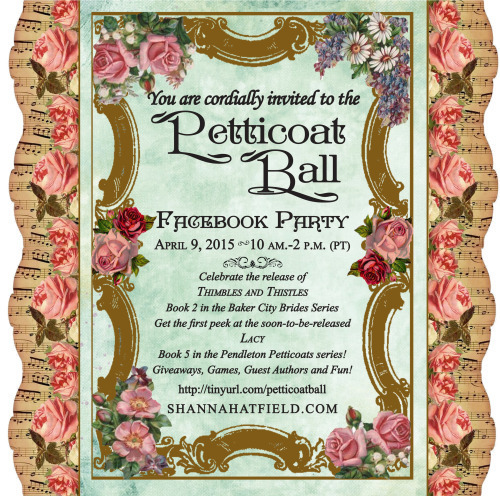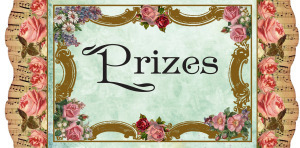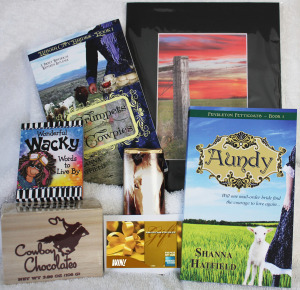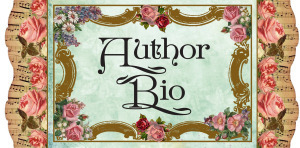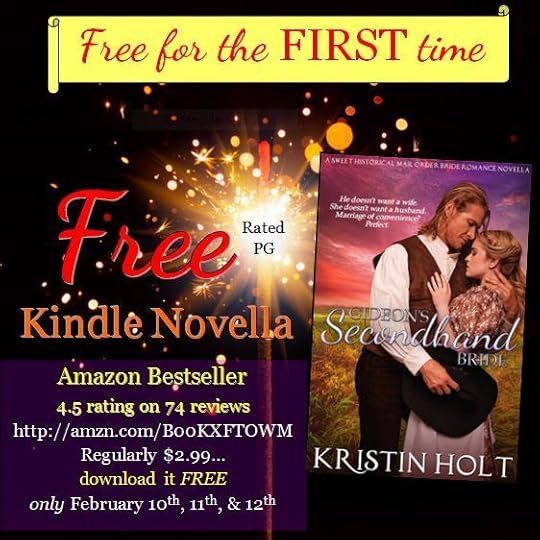Kristin Holt's Blog, page 38
May 26, 2015
Victorian Era: the American West
Queen Victoria reigned from age 18 to age 81; June 1837 until her death in 1901. Anything that falls within this time, whether those English-speaking countries were her subjects or not, is referred to as the Victorian Era.
While studying history, I remember the surprise of applying Queen Victoria’s reign to my nation’s democratic republic. Why wouldn’t we (the United States of America), having dispensed with England’s rule, label time frames by Presidents’ administrations or by some other measuring stick?
I was young. I didn’t understand the bigger picture. I still don’t comprehend all the reasons why, but it’s true. The American West had a Victorian Era. That’s why, within Amazon’s book (both print and eBook) categories, you’ll find Romance—a major category of fiction—broken down into (among many other options) Historical Romance and thence to Ancient World, Medieval, Regency, Scottish, and Victorian. If I had any persuasive power, I’d try to get an “American West” category in there, too, but evidently Amazon figures they know what they’re doing. Given these five categories within Historical Romance, the clear fit for your typical Mail Order Bride-themed novel is Victorian.
After all, that’s the era when these books are set.
Western Expansion happened while Queen Victoria sat on the throne.
The United States forced the Cherokee from Georgia to make room for white settlers and their slaves.
The Mexican-American War brought about the annexation of Texas (which included more than the state borders we know today).
Oregon, with her rich soil and promise of abundance, called to the young and hale. Every late winter, companies congregated in “jumping off” places such as Council Bluffs and St. Joseph, and headed west on The Oregon Trail as soon as forage was available for their animals.
Mormon pioneers forged a trail west, and for the first time, an enormous body of people emigrated beyond the borders of the then United States and into territory owned by Mexico.
Gold changed the course of the history of the world as ships sank anchor and abandoned vessels in the Golden Gate Harbor.
The Yukon became region of significant interest with the Klondike Gold Rush.
The Homestead Act aided a great surge of westward migration.
The issue of slavery wore threadbare the fabric of unity in the United States and the Kansas-Nebraska Act prompted a surge of settlers into those territories.
The American Civil War was fought. 620,000 Americans died; more than in any other war.
The golden spike commemorated the grand accomplishment of a transcontinental railway while Victoria remained Queen of England and all British subjects.
Electric lights came into vogue and large cities followed the great King Kamehameha of Hawaii whose palace had electric lights and telephones before the White House.
Nineteen states joined the Union: Florida, Texas, Iowa, Wisconsin, California, Minnesota, Oregon, Kansas, West Virginia, Nevada, Nebraska, Colorado, North Dakota, South Dakota, Montana, Washington, Idaho, and Wyoming.
The Great Chicago Fire destroyed a significant portion of the city—and many lives were lost.
Numerous inventions occurred during the Victorian Era.
This list is far from complete: dental anesthesia, antiseptics, dental chair, safety pin, telegraph, postage stamp, air brakes, traffic lights, metal windmill, mail-order catalog, barbed wire, shoe welt stitcher, telephone, sewing machine, four-stroke internal combustion engine, carpet sweeper, cylinder phonograph or tin foil phonograph, moving pictures, light bulb, toilet paper, seismograph, metal detector, roll film for cameras, automatic player piano, paper-strip photographic film, rayon, fountain pen, mechanical cash register, steam turbine, machine gun, first practical automobile to be powered by an internal-combustion engine, gasoline operated motorcycle, dishwasher, world’s first four-wheeled motor vehicle, Coca-Cola, radar, gramophone, contact lenses, paper drinking straws, pneumatic tire, AC motor and transformer, matchbook, smokeless gunpowder, elevator, escalator, diesel-fueled internal combustion engine, vacuum flask, the zipper, carborundum, motion picture camera, the rubber heel, roller coaster, motor-driven vacuum cleaner… and that’s all pre-1900.
The Titanic sank approximately 11 years after Victoria’s death.
All in all, Queen Victoria reigned 63 years, 7 months—longer than that of any other British monarch and the longest of any female monarch in history. [Queen Elizabeth II is an exceptionally close second. On 6 February 2015, she had reigned 63 years.]
That’s a lot of living for a young United States, ranging from age 61 years to 125 years of age.
During those many years of a long-lived monarch, Queen Victoria’s influence was greatly felt in the United States. Americans may have severed ties with the throne of England, but one small example of Her Majesty’s influence is the tradition of bridal white; Victoria’s choice of a white wedding dress was later echoed by debutantes and the wealthy (anyone to whom a white dress wasn’t impossible or ridiculously impractical) in the States (or as Victoria would have said, “the Colonies”). For an interesting opinion on the queen’s influence on the United States, see this online response to this very question.
The Victorian Era—spanning nearly 64 years, began at a time when “the west” was considered anywhere west of the original 13 colonies. Missouri was a rough frontier where adventurous souls lived well beyond the border of ‘civilization’. The Ohio river valley was home to a few hardy souls. Consider just how far East the current state of Ohio is, given the map of the United States now. By the end of the Victorian Era (1901), only six of today’s States had not yet joined the Union.
The ‘Wild West’ is a term known as an Americanism (it originated in the United States). It first shows up in documented print between 1850 to 1855. It was also known as the Old West or the Frontier. Wikipedia offers a marvelous timeline of events in the Old West period.
Bottom line: Yes. Despite the fact Victoria did not reign over the “American Colonies”, The United States of America did, indeed, have a Victorian Era. These six decades cover a vast range of circumstances, events, progress, military action, inventions, and more. No wonder so very many historical romances are set in the Victorian Era.
Please respond to this post, answering this question: What occurrence in American history is your favorite setting for a romance novel, and why?
Copyright © 2015, Kristin Holt, LC
May 24, 2015
How Much Research Does It Take?
READERS ASK: how much research does it take to produce an historical romance?
MY ANSWER: it depends… on many aspects.
It depends on how much the author already knows about the setting, the era, the political climate, well-known (at least to those versed in history) events that coincide with the book’s time line. For instance, if I were to set my story in Chicago in October of 1871 and failed to at least mention the Great Chicago Fire… I’d be toast. Most fans of historical fiction (whether romance or mystery or thrillers or any combination) would say, “Hey! That’s not accurate!”
Some readers of historical romance are true history buffs. Whether they’re history majors, professors of American History, or simply read everything they can get their hands on about their favorite era in the world’s back story, some are simply very well-informed.
Every writer has to research enough to please the most savvy of readers while avoiding the trap of ‘falling in’ and studying so much the fiction never ends up on the computer screen.
A writer needs to know enough about every little detail as to please history buffs while weaving the truth of available inventions and evolution of the English language without miring the characters and storyline in too much trivia. It’s a balancing act. Yet one of the beautiful things about writing fiction is that it’s fictitious. If I wanted to create a late-season blizzard that stalled the train transporting mail order brides to Prosperity, Colorado— I could fabricate said freak storm in May of 1881 and claim artistic license. Typically when authors move true historical events around, dropping them into an order that suits their purposes or fabricates something that could have happened, they’ll make a note of said artistic license at the book’s back matter. To put the notice up front might give away a little too much of the story ahead of time, and that’s no fun.
Some authors research before they begin writing, others look details up as the first or second draft takes shape (and they know what information is needed), and others outsource the research altogether. I tend to regularly immerse myself in researching interesting tidbits of the late 19th century so I have a framework of understanding and background knowledge to draw from. I do a lot of research as the first draft develops, especially as I realize some aspects need fact checking.
In my opinion, the setting should be an integral part of the historical romance… and the novel couldn’t be arbitrarily moved to another era, another locale, another century with no more than a cursory adjustment. I hope I’ve succeeded in bringing the setting of Prosperity, Colorado to life, that you could picture the scenery, the inhabitants, the stark differences of this remote camp from Evelyn’s home in New York City.
Research can be done easily in this era of the Internet, with a wealth of information a mere search away. Some still visit brick-and-mortar libraries and browse paper-and-ink resources to gather information to enrich their writing. Others do first-person research such as interviewing the last vestiges of those who lived in the era. It makes sense to interview World War II veterans when writing a book set in the era. No one knows more about the subject that one who lived it.
Some of my research came in this first-hand account of the life and times of the late 19th century. I’m very blessed to have a living grandmother who is now in her 90s and was born in 1920. While she didn’t live in 1881, her grandmothers, grandfathers, parents, aunts and uncles did. She knows their stories. She heard all about the circumstances that brought these intrepid pioneers west to settle the Great Basin Desert. Her father (my great grandfather) owned and operated a mercantile in a tiny town and I’ve loosely based Sam Kochler’s store (The Bride Lottery) on tales I’ve heard my grandmother relate about her father’s business.
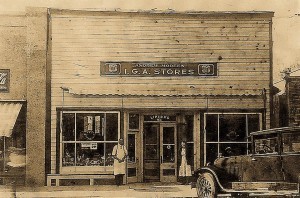
My Great-Grandfather’s Store
In other blog posts, I’ll brief you on some of the elements of research I conducted while preparing for and writing The Bride Lottery. My purpose to to share some of the fascinating, true-to-history details you might enjoy. After all, who knew women wore maternity corsets? I’ll admit I had no concept of such a thing before researching corsets for this novel… after all, I’d not written a pregnant heroine before. Sure, I knew all about corsets in the latter half of the 19th century, and that many women on the frontier dispensed with them altogether, but once I knew expectant mothers wore special corsets—not to maintain a waspish waistline, but to safeguard a healthy pregnancy— I knew mention of such societal expectations had to make its way, as naturally as possible, into the book.
So, how much research does it take to produce an historical romance?
Ask five different authors, and you’ll determine one size does most certainly not fit all.
My best answer: “Enough.”
Copyright © 2015, Kristin Holt, LC
May 21, 2015
My Writing Process, Part 2


Part 2
Rough Draft, Second Draft, Beta Readers, Apply Suggestions, Format & Publish, Independent Publishing
Note: Yesterday’s post, My Writing Process, Part 1 included: Branding, Software (Scrivener), Ideas are Everywhere, and 7-Point Story Structure. Please consider visiting that post, as today’s picks up where yesterday’s left off.
“Writing a first draft and reminding myself that I’m simply shoveling sand into a box so that later I can build castles.” ~ Shannon Hale
Author Shannon Hale nailed that one on the head.
She and I must have a very similar view of rough drafts.
Rough drafts are a necessary part of the project. Rough by definition… and they’re supposed to be. Why would I spend hours and hours polishing my words, sentences, paragraphs, formatting— and more importantly, my scene and sequel structure when this content might not stay?
For me, a first draft is all about deciding what stays and what goes.
And there’s no way to determine that until I have a chance to see it in written form and let the characters show me where the story will go, how it will develop, and what becomes of my jumping-off-place (my 7-point structure outline).
Frankly, The Bride Lottery was easy to write (compared to other books of mine). It’s a prime example of how, for me, a simple, basic outline (without too many details— the 7-point structure) makes all the difference. I spent two or three hours figuring out the 7-Point Structure per Dan Wells’s method, and voila! … ready to power through the first draft.
I love it when a plan comes together.
Sometimes, I’ve been very surprised— and not in a good way. Specifically, with Maybe This Christmas. Wow… now that one went nowhere near my original concept. Yet by the end of the (very lengthy) rewrite process, I was happy with the results.
Without that first draft, I never would have known what stays and what goes. I wouldn’t know where to spend my time. Getting it all down (digitally, in Scrivener) is the priority, and I give myself full permission to write what my original writing teachers referred to as Puke Green Dreck. Because it is. It’s seldom beautiful. It’s seldom perfect… OK, it’s never perfect.
But I can’t fix something that isn’t on ‘paper’.
As Shannon so eloquently put it, in my first draft, I’m shoveling sand into a box so I can later build castles.
When they asked Michelangelo how he made his statue of David he is reported to have said, “It is easy. You just chip away the stone that doesn’t look like David.” ~ Michelangelo
I understand what the incredibly talented, hard-working, highly skilled artist meant.
And I have zero delusions that I might be as creative as he, but I still try and apply his wisdom to my writing.
A second draft, to me, is about removing everything that doesn’t belong, and ensuring all the important stuff stays.
I doubt Michelangelo had Super Glue. But I have the relative ease of a word processing program designed for all kind of writers, and if I find something needed to stay, it’s easy to put it back.
Second drafts, for me, are a fluid process. I mark up my draft (Scrivener makes this easy with an Inline Annotation feature). I leave the equivalent of digital sticky notes for myself in the Project Notes or Document Notes field to address later. I attack the biggest problems first— a better starting place, a dropped character, the best circumstances/set-up for the ending. Why polish and manage every turn of phrase when I’m not sure the sentence/paragraph/scene will stay in the finished book? (Yes, I’m repeating myself; it’s something I have to remind myself of throughout the writing process because it’s a break with what I once did.)
Eventually— sometimes after three drafts, sometimes after even more— I’m ready to polish, refine, smooth out the rough places. I cannot imagine shaping marble with hand tools. I’ll stick with word smithing. Words make ever so much more sense to me.
I had it easy. Language classes in elementary school made sense. I remember asking my mother why it was simple to remember the correct usage of words (I believe we were studying noun-verb agreement) in sentence structure, when so many of the kids in my class found it difficult. She had a bit of wisdom to share with me that day: I’m a reader and I was blessed with literate parents who use the English language properly. I think it’s more than that— I think I lucked out. Language arts came easily to me… and math did not. I kid you not… math is so not my thing. I can’t do mental math. Scoring weekly Pinochle games maxes out my capacity.
Because sentence structure, spelling, homophones and homonyms, and genesis of the language magically work with my brain, I work diligently to ensure I pass the cleanest copy possible to my beta readers. This is purposeful. Why would I waste their one true cold read, causing them to trip over misspellings, dropped words, and poor word choices, when what I need from them is to bring to my attention what I cannot see.
“Readers are plentiful: thinkers are rare.” ~ Anthony Burgess
By the time I pass any book off to my beta readers, it’s as ready as I can make it. It’s clean, clear, concise. My very best work.
And every single time, my beta readers come back with suggestions.
This is precisely why I value their feedback and why I ask for it.
I need their capacity to see what I can no longer see… as the creator of my own little story world, I think something is there when it’s not (a dropped word or adequate character motivation or something else important).
Through the years, I’ve picked up new beta readers and said goodbye (for one reason or another, officially or unofficially) to others. This is perfectly OK. I’m asking for a lot. I’m asking them to read and give me their honest feedback… and that’s sometimes hard to do.
I’ve lucked out, truly, I have… and have developed lasting and precious relationships with other authors who are skilled, compassionate, and as vested in my success as anyone could possibly be. I know their hearts are in the right place and their feedback is designed to help. They read for me, I read for them, and we’ve developed the kind of trust in one another that is invaluable.
“True intuitive expertise is learned from prolonged experience with good feedback on mistakes.” ~ Daniel Kahneman
I take every scrap of information into consideration. I revise. I rewrite. I cut, I write fresh stuff. Eventually, it’s as smooth and beautiful and complete as I can make it.
At this point, some Indie Authors pay an editor to work their magic. Editors are like a beta reader to the nth degree (I do understand that math term). Editors have the training, skill, talent, and capacity to find anything and everything standing in the way of a glossy, marketable product readers will gladly pay for and thoroughly enjoy reading.
I freely admit I don’t hire an editor.
Go ahead— gasp.
Shake a finger at me. Scold me for taking an unnecessary risk.
After all, every reader who scans reviews others have left on a book before making a purchase knows that readers have little to no patience with poorly edited work. Readers can and do leave honest reviews criticizing a book that so clearly needed a professional edit and the author skipped that critical, essential step.
So I’ll restate, with emphasis: I don’t hire an editor.
I didn’t say my books aren’t meticulously edited, because they are.
I edit my books.
I take it seriously. I carefully devote the necessary time to ensure it’s as clean and error-free as possible.
And given how many definitely-wrong (not just a stylistic difference) errors I’ve found while beta reading for other authors, post-editor’s work, I have a humble confidence in my ability to find and correct the problems. My beta readers are skilled, capable, careful readers who don’t miss much.
So far, it’s a system that’s working.
Once the book is done, next comes the publishing part.
Numerous professionals are in the business of assisting authors in formatting their work for publication, in eBook format(s) and for print.
I could go that route, of course. It’s my decision.
But I’ve found I enjoy the creative outlet. With each book I complete, format, and publish, the time invested becomes shorter and shorter because I finally know what I’m doing. I’ve ironed out the problems. I’ve learned how to do it well. I like it, so I do it myself.
“Indie publishing lets me feed my inner control freak.” ~ Michelle M. Pillow
I’ll do it myself.
That pretty much sums up my plan of action.
Years ago, I signed a contract with a well-known literary agent in New York. She was the agent of a good many authors of sweet western historical romances sold to Harlequin Historical… my target publishing house at that time. This agent believed my book would be an easy sell.
But the market was changing. Harlequin was making adjustments to their Historical line, and the “Gatekeepers That Be” said no.
They had all the power. And they didn’t want to let me through.
Thank goodness times have changed.
I’m proud to be an Indie Author.
Indie is short for Independent.
I’m a businesswoman, an artisan, a publisher. A one-woman show. I make the decisions, and if it turns out I chose poorly, the consequences are all my own.
I have the final decision about the content in my books. I chose my brand, my genre, my niche.
I’m responsible for copyright, blurbs, tag lines, and back cover copy.
I work with a cover artist to ensure the presentation represents my work the best it possibly can. I design and sew costumes for era-appropriate photo shoots— or I rent the costumes. I hire models. I pay the bill.
I study the craft. I attend conferences. I learn from every beta reader’s feedback. I study the market. It’s up to me to be well-informed, knowledgeable, and prepared.
I set the prices for my books. I market my titles. I promote them. And I pay the bill.
I hire an attorney when needed. And I pay the bill.
I developed my own author website, I update it, I ensure the content remains relevant. Or I pay some else to do it.
I format my books for Kindle and for other eBook retailers (sometimes)… and I take pride in doing this task well. I create a presentation that is pleasing to the eye and gives the reader a pleasurable reading experience. Or I could pay the bill to have someone else do it.
I format my books for paperback. It’s time-consuming, rewarding work. I enjoy the creative outlet. Or I could pay a professional to do it for me.
I’m responsible for my own ISBNs. It’s one of the costs of doing business.
If the cover is not successful, I go back and rework it. The buck stops with me. And that means I pay for another round of cover art.
I take full and complete responsibility for the quality of my publications. I’m in this career for the long haul. Readers are the quality controls— they leave honest reviews and their feedback guides my decisions going forward.
I’m an Indie Publisher.
I’m an Indie Author.
Copyright © 2015, Kristin Holt, LC
May 20, 2015
My Writing Process, Part 1


Part 1
Branding, Software (Scrivener), Ideas are Everywhere, 7-Point Story Structure
Put three writers in a room, ask them how they go about writing a book, and you’ll get three very different answers.
Authors are as unique in their methods as in their fingerprints.
Beginning writers may study books, attend courses, learn from highly successful authors in one way or another, but eventually—through trial and error—they’ll figure out what works for them. There are no right ways, no magic bullets, no fantastic formulas, just as there are no wrong ways. Just as we all might set out from Atlanta, destination, Chicago… we’ll all get there taking a variety of personally selected routes. We’ll fly. Or drive. Take the interstate or back roads. Some will push through with 16 hour days, while others spend more time visiting stops along the way and arrive much later. Nothing wrong with any of it.
Given authors are individual about the process they use to create a book, I want to share my own methods… in case it piques your curiosity.

“A good brand provides a clear and memorable sense of what your business stands for.” ~Unknown
My brand is sweet (wholesome) western historical romance. That’s what I write, that’s what I’ll continue to write (at least for a while). I want readers to know what to expect when they pick up another of my books, and I certainly don’t want them to be (unpleasantly) surprised.
This means I focus on writing yet another book with the same level of sensuality (very mild), language content (family friendly), era in history, level of humor, and more.
I may branch out someday, but to do so now would be counterproductive and I know it.

“When a friend recommended Scrivener to me several years ago, I wondered what it could possibly do that my standard word processor couldn’t. Boy, was I shocked! Happily so. I bought the software immediately and haven’t looked back.” ~ Gwen Hernandez
While I’m proficient with Microsoft Word, I’ve fallen in love with Scrivener, (so much more than) a word processing program for writers. I use it through every step of the creative process for a number of reasons, including:
Organization
Planning
Tracking changes
Holding onto deleted scenes or outtakes
Moving scenes around
Ease in finalizing the file for Kindle or Nook (or any other format)
Indie Author’s best friend (so easy to drop in images!)
While it has a steep learning curve (I’m not the only one who thinks so), numerous resources exist

“Everybody walks past a thousand story ideas every day. The good writers are the ones who see five or six of them. Most people don’t see any.” ~ Orson Scott Card
I have a (slightly annoying) habit of asking friends, coworkers, associates how they met their partner. You could say I collect “cute meet” stories. I’m fascinated with the circumstances that unite previously unknown to each other people who end up connecting, falling in love, and committing.
After all, writing about that very miracle is my business.
I’m a romance writer.
Cute Meets are one thing. Workable plots, with adequate conflict to carry a story from beginning to end is a whole ‘nother thing.
Every last one of my plots has worked best while intentionally looking at potential ideas for conflict within the story.
No conflict means no story.
I don’t mind admitting learning this element has been a genuine struggle. No one wants to read about happy characters who fall in love and live happily ever after—unless they surmount huge obstacles in order to find that happiness. Again, no conflict, no story.
My favorite way to look at conflict (what does the character want, and why can’t s/he have it?) is by working diligently through a simple exercise called Seven Point Story Structure.

“Character is plot, plot is character.” ~ F. Scott Fitzgerald
I’ve tried a number of things to get, finally, to a place where plotting a book actually works—for me and for my beta readers. Thank goodness the majority of those who’ve read my books never saw the anguish in multiple rewrites and finally getting to a place where the story could see the light of day.
Some books have gone through enough serious, gut-wrenching, tear-it-apart-and-start-over rewrites I could’ve completed three books in that same time span. That’s pain, people. Natural childbirth is easy compared to that kind of revision agony.
All that changed when an author-friend introduced me to Dan Wells’s Seven Point Story Structure. Wow. A whole new universe, and it made sense to me from day one. If you’re curious, interested, or have an hour to kill, see Dan Wells’s presentation on this amazing method on YouTube.
I’ve created a worksheet that mirrors this method. Because it’s digital, it expands to fit the need. It’s in Word, I save often, and once the 7-Point Structure is complete, I’m ready for a rough draft because I know exactly what needs to happen.
Please join me tomorrow for Part 2. I’ll share more of my Writing Process: Rough Draft, Second Draft, Beta Readers, Apply Suggestions, Format & Publish, and Independent Publishing.
Copyright © 2015, Kristin Holt, LC
May 12, 2015
Corsets in the Era: Yes, even Maternity Corsets
Ladies undergarments have changed significantly through the centuries. Personally, I can’t even imagine “waist training”… and wearing a corset with the intention of minimizing my waist. But it wasn’t just about constricting soft tissue… corsets actually funneled the ribcage into a tighter vee, thus increasing the overall effect of a tiny midsection. A distinguished anatomist William Henry Flower published a book in 1881 demonstrating by text and illustrations the deformities caused to female anatomy by corsets. This did not prevent his wife and four daughters from wearing them.
Corsets were marketed as a health necessity, and conscientious mothers put children in corsets as early as five or six years of age. Corsets were touted as a good-health measure.
I’m not surprised women in the 19th century would give up comfort for sake of fashion (because we still behave this way today— why else would we wear high heels?). As the Empire silhouette (think Pride and Prejudice dresses) gave way to fuller skirts, the waist became the ultimate focus of female fashion. The corset assumed the dominant role it would hold for the rest of the 19th century. Designed to emphasize the waist, it was pulled in as required to achieve the desired slenderness. Unnaturally tiny waist measurements were considered fashionable, desirable, and smart.
During the height of the ‘waspish’ waistline in fashion, young ladies reduced the 18-inch waistline to a more desirable 16-or 15-inches. The very snug corsets were referred to as “tight lacing”, and doctors and others criticized the practice to be met with pushback from those who claimed to find it beneficial as well as enjoyable.
Given the general attitude about foundation garments in the era, I shouldn’t have been surprised to learn women (especially those in “civilized” and settled portions of the United States) felt strongly about maternity corsets.
In the Journal of Social History, Leigh Summers provides a well-rounded explanation based upon a variety of sources: costume artifacts, women’s magazines, patterns, advice books, corset tracts, and advertisements to describe their design and use. In a summary of this journal, Summers suggests that women who wore maternity corsets, as with corsets generally, were simply conforming to prevailing standards of beauty and femininity linked to respectability, reputation, and thus class status and security.
Summers contends that maternity corsets shielded the pregnant body from view and thus provided Victorian society a means of denying women’s sexual activity in conformity with prevailing ideologies. This effect allowed women greater opportunities to remain actively engaged in public longer, rather than hidden in confinement.
Not all corsets were meant for non-pregnancy. Many had been designed for healthful support of a growing fetus. Without one, advertisements exclaimed (and societal norm decreed), a woman couldn’t possibly expect a healthy pregnancy.
Incredible.
A Gossard Maternity Corset advertisement, exclaimed “Better Babies”… the slogan heard everywhere. The advertisement promises perfect abdominal support, and muscles of the back and abdomen are relieved. Oh, and shipping comes in a plain package. (Must be embarrassing to order a maternity corset.) Gossard certainly wasn’t the only company to advertise maternity corsets.
In The Bride Lottery (Prosperity’s Mail Order Brides, Book 1), I intentionally ensured Evelyn Brandt, a sheltered young lady raised in one of the best households of the New Rich in New York City, knew very little about pregnancy. This rings true, historically, as Victorians were so repressed about matters of human sexuality it never would’ve been discussed until her impending marriage. Even then, information would’ve been scarce. Surprised I called Evelyn Brandt and her family Victorians? It doesn’t matter one whit that they weren’t under English rule; the mere fact that Victoria sat on the English throne made it the Victorian Era throughout the English-speaking world.
Back to Evelyn Brandt and a maternity corset. I personally adore the scene wherein Evelyn uses the essential need for a corset as an excuse to discern whether Sam Kochler is interested in her as a potential bride (no matter what he’s told everyone)… or simply as a paying customer. Naturally, her friend Caroline would know something of the matter (corsets for expectant mothers) as she has younger, married sisters who have already given birth.
Had my character, Evelyn, ‘behaved’ herself, been a good daughter of the Upper 500 (Father had his business reputation to maintain, after all), she would’ve married a man her father approved of… if not a man her father carefully selected. In doing so, she would have had her mother’s assistance in ordering a trousseau from dressmakers (and corset manufacturers)… and when it came time for the blessed event and she was in the family way, no doubt an elder sister and/or her mother would’ve ensured Evelyn had proper undergarments and understood when it was time to go into confinement (seclusion) until she not only gave birth to the heir but her corset did fit properly once more. I wasn’t making any of that stuff up. True historical expectations.
Can you imagine?
In today’s world, women have the flexibility of working right up until they deliver and returning to work (and the public eye) as soon after birth as wished. Women wear whatever they want to for maternity clothes… snug fitting, loose fitting, boy-friend fit jeans that ride so low on their hips ‘maternity’ pants aren’t necessary.
Things have changed.
Wouldn’t the suffragists be delighted?
Copyright © 2015, Kristin Holt, LC
April 27, 2015
April 7, 2015
Welcome to the Petticoat Ball Blog Tour; a Celebration of two new sweet historical romances by Shanna Hatfield
Welcome to the
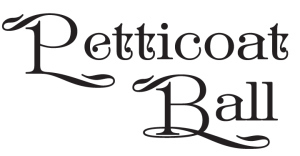 Blog Tour!
Blog Tour!A celebration of two new sweet historical romances by Shanna Hatfield
Meet Thane and Jemma Jordan of Baker City Brides
Two key characters from Shanna Hatfield’s historical series, Baker City Brides, visit us today. Set in the western town of Baker City, Oregon, this series of sweet romances highlights determined women and the men who fall for them in the 1890s.
Welcome Mr. and Mrs. Jordan. Tell us a little about how you met.
Thane: Jemma’s sister, Jane, was married to my brother, Henry. Upon Henry’s death, I traveled to England to settle his estate and discovered I had a niece and nephew. They lived with Jemma. She’d taken care of them both, even before Jane passed away giving birth to Lily.
Jemma: Little did I know when this cowboy showed up on my doorstep that he’d turn my world all topsy-turvy. In order to travel back to his ranch together, we wed a few weeks after his arrival.
So you married a complete stranger?
Jemma: Not willingly. (Grins at Thane) He inherited the children and I couldn’t bear to be separated from them. The only way for me to stay with them and not create a scandal was to wed this scoundrel.
Thane: (Kisses Jemma’s cheek) She was the most annoying, irritating, stubborn, opinionated female I’d ever met. She also happened to be the most beautiful.
Jemma: (Blushes and squeezes Thane’s hand) Despite his ability to infuriate me beyond reason, he really does say the nicest things.
Tell us what it’s like living on the ranch.
Thane: It’s a little slice of heaven. We’re about an hour from Baker City, to the south. We have rolling hills full of fat cattle and a good crew that keeps everything running smoothly. I also raise and train horses.
Jemma: He forgot to mention we live in a tiny little cabin barely big enough for our dog much less two adults and two lively children. There isn’t a drop of running water. The worst thing is the abominable shack we must use that serves our personal needs. (Jemma shudders) It’s positively detestable.
Thane: (Smirks) What my lady refers to as an abomination is our outhouse. It’s just a part of life where we live.
What’s the most exciting thing happening right now?
Jemma: (Glances at Thane and smiles) Thane is building our new home with running water and honest-to-goodness bathrooms. I can hardly wait until it’s finished.
Thane: I caught her crying over the bathtub we installed the other day. She was sobbing about how pretty it was and how much she loved it. I’m pretty sure she holds a greater affection for the bathtub than me.
Jemma: I did no such thing and you know it. (Swats Thane’s arm) Why, that’s utter nonsense. I merely stated how wonderful it would be to soak in a real tub with water that didn’t have to be heated and hauled. My gracious, Thane Jordan!
Thane: (Leans toward interviewer and speaks in a whisper) See why it’s so much fun to ruffle her bloomers? (Sits back up and winks at Jemma) The other exciting tidbit is that our lumber supplier has gone daffy for one of our good friends, but Maggie’s running away faster than he can catch her.
Jemma: Maggie isn’t nearly as opposed to Ian as she tries to convince everyone. I think secretly she likes him.
Thank you for joining us. Any parting words for our readers?
Thane: Thank you for hosting us today. If you enjoy sweet romances set in the past, I hope you’ll consider reading our stories in Crumpets and Cowpies and Thistles and Thimbles.
***
Discover more about the Jordan Ranch and life in 1890 Baker City in Crumpets and Cowpies, the first book in the Baker City Brides series.
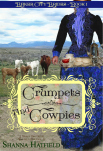 In the story, rancher Thane Jordan reluctantly travels to England to settle his brother’s estate. He quickly discovers he’s inherited much more than he could possibly have imagined, including a niece and nephew he didn’t know existed. The children’s aunt, Lady Jemma Bryan has no desire to spend a single minute in Thane Jordan’s insufferable presence much less live under the same roof with the handsome, arrogant American. Forced to choose between poverty or marriage to the man, she travels across an ocean and America to reach his ranch in Oregon.
In the story, rancher Thane Jordan reluctantly travels to England to settle his brother’s estate. He quickly discovers he’s inherited much more than he could possibly have imagined, including a niece and nephew he didn’t know existed. The children’s aunt, Lady Jemma Bryan has no desire to spend a single minute in Thane Jordan’s insufferable presence much less live under the same roof with the handsome, arrogant American. Forced to choose between poverty or marriage to the man, she travels across an ocean and America to reach his ranch in Oregon.
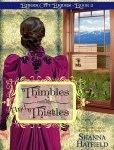 The second book in the Baker City Brides series releases Thursday, April 9!
The second book in the Baker City Brides series releases Thursday, April 9!
Thimbles and Thistles takes readers back to Baker City as spring arrives and love is in the air. You can reserve your Kindle copy here: http://amzn.com/B00TCV6BFG
Maggie Dalton has no need for a man in her life. Widowed more than ten years, she’s built a successful business and managed quite well on her own in the bustling town of Baker City, Oregon. Aggravated by her inability to block thoughts of the handsome lumber mill owner from her mind, she renews her determination to resist his attempts at friendship.
Full of Scottish charm and mischief, Ian MacGregor could claim any available woman in Baker City as his own, except the enchanting dress shop owner who continues to ignore him. Not one to give up on what he wants, Ian vows to win Maggie’s heart or leave the town he’s come to love.

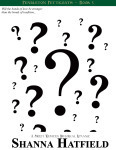 Lacy, Book 5 in the Pendleton Petticoats series, will be available for pre-orders April 9.
Lacy, Book 5 in the Pendleton Petticoats series, will be available for pre-orders April 9.
Be among the first to order the long-awaited story of Grant Hill. Talk about losing at love… eligible banker bachelor Grant needs to find the right girl.
Those attending the party will also get a first look at the cover!
“Will the bonds of love be stronger than the bonds of tradition…”
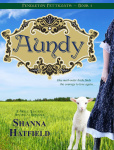 It just wouldn’t be a party if there wasn’t a book available for free! Aundy, Book 1 in the Pendleton Petticoats series, will be available for free Kindle downloads April 9. Make sure you grab your copy! If you’ve already read it, tell your friends to download it. If you haven’t met the characters from Pendleton Petticoats, here’s a brief intro:
It just wouldn’t be a party if there wasn’t a book available for free! Aundy, Book 1 in the Pendleton Petticoats series, will be available for free Kindle downloads April 9. Make sure you grab your copy! If you’ve already read it, tell your friends to download it. If you haven’t met the characters from Pendleton Petticoats, here’s a brief intro:
Aundy (Book 1) – One stubborn mail-order bride finds the courage to carry on when she’s widowed before ever truly becoming a wife, but opening her heart to love again may be more than she can bear.
Caterina (Book 2) – Frantic to escape a man intent on marrying her, Caterina starts a new life in Pendleton, completely unprepared for the passionate feelings stirred by the town’s deputy sheriff.
Ilsa (Book 3) - Tired of relying on others to guide and protect her, Ilsa finally finds the strength and courage to take control of her life. Unfortunately, her independence drives a wedge between her and the man she’s come to love.
Marnie (Book 4) – After giving up on her dreams for a future, Marnie finds her hope rekindled by one caring, compassionate man and the orphans who need her.
Dust off your dancing shoes and choose your formal attire for the Petticoat Ball Party on Facebook April 9, 2015 from 10 a.m. to 2 p.m. Giveaways and games will make for a splendid event as we celebrate the release of Thimbles and Thistles and the debut of Lacy!
The talented and fabulous guest authors joining in the shenanigans include:
10 a.m. – Julie Lence
10:30 – Kathleen Ball
11 – Rachel Rossano
11:30 – Christina Cole
Noon – Peggy Henderson
12:30 – Kristin Holt
1 p.m. – Karen Witemeyer
1:30 – Kayla Thomas
Invite your friends to the party, and you could win a $25 Amazon Gift card. Go to the Facebook Party Page, click on the “invite” button, invite your friends, then post how many you invited. One randomly drawn person will win, but you get additional entries for every 25 people you invite! Also, ask your friends when they join the party to share that you invited them on the party wall. Each friend who mentions your name, earns you another entry in the contest! The winner will be announced prior to the start of the party April 9! http://tinyurl.com/petticoatball
To enter the drawing for a $50 American Express gift card, autographed books, digital books, chocolates, and original western artwork, fill out this form. http://tinyurl.com/petticoatballprizes
 A hopeless romantic with a bit of sarcasm thrown in for good measure, Shanna Hatfield is a bestselling author of sweet romantic fiction written with a healthy dose of humor. In addition to blogging and eating too much chocolate, she is completely smitten with her husband, lovingly known as Captain Cavedweller.
A hopeless romantic with a bit of sarcasm thrown in for good measure, Shanna Hatfield is a bestselling author of sweet romantic fiction written with a healthy dose of humor. In addition to blogging and eating too much chocolate, she is completely smitten with her husband, lovingly known as Captain Cavedweller.
Shanna creates character-driven romances with realistic heroes and heroines. Her historical westerns have been described as “reminiscent of the era captured by Bonanza and The Virginian” while her contemporary works have been called “laugh-out-loud funny, and a little heart-pumping sexy without being explicit in any way.”
She is a member of Western Writers of America, Women Writing the West, and Romance Writers of America.
Find Shanna’s books at:
Amazon | Amazon UK | Barnes & Noble | Smashwords | Apple
Shanna loves to hear from readers! Follow her online:
ShannaHatfield | Facebook | Pinterest | Goodreads | You Tube | Twitter
March 25, 2015
Prosperity, Colorado: Fictitious Community in a Very Real Place
March 18, 2015
New Series: Prosperity’s Mail Order Brides, and Series vs. Serials
February 10, 2015
FREE Kindle Bestselling Novella–Gideon’s Secondhand Bride
Free for the FIRST time!
Gideon’s Secondhand Bride: A Sweet Western Historical Mail Order Bride Romance Novella (Rated PG)
4.5 rating on 74 reviews
Regularly $2.99
Kristin Holt's Blog
- Kristin Holt's profile
- 117 followers



